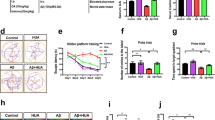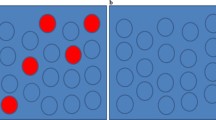Abstract
Although studies have shown that excitotoxicity mediated by N-methyl-D-aspartate receptors (NMDARs, NR) plays a prominent role in Alzheimer’s disease (AD), the precise expression patterns of NMDARs and their relationship to apoptosis in AD have not been clearly established. In this study, we used Abeta (Aβ) 1-40 and AlCl3 to establish AD rat model. The behavioral changes were detected by morris water maze and step-down test. The hippocampal amyloid deposition and pathological changes were determined by congo red and hematoxylin-eosin staining. Immunohistochemistry was used to detect expression of NR1, NR2A and NR2B, and TUNEL staining was used to detect apoptosis. Results showed that water maze testing escape latency of AD-like rats was prolonged significantly. Reaction time, basal number of errors, and number of errors of step-down test were increased significantly; latency period of step-down test was shortened significantly in AD-like rats. Amyloid substance deposition and obvious damage changes could be seen in hippocampus of AD-like rats. These results suggested that AD rat model could be successfully established by Aβ1-40 and AlCl3. Results also showed that expression of NR1 and NR2B were significantly increased, but expression of NR2A had no significant change, in AD-like rat hippocampus. Meanwhile, apoptotic cells were significantly increased in AD-like rat hippocampus, especially in CA1 subfield and followed by dentate gyrus and CA3 subfield. These results implied that NR2B-, not NR2A-, containing NMDARs showed pathological high expression in AD-like rat hippocampus. This pathological high expression with apoptosis and selective vulnerability of hippocampus might be exist a specific relationship.




Similar content being viewed by others
References
Goedert M, Spillantini MG (2006) A century of Alzheimer’s disease. Science 314:777–781
Dartigues JF (2009) Alzheimer’s disease: a global challenge for the 21st century. Lancet Neurol 8:1082–1083
Brookmeyer R, Johnson E, Ziegler-Graham K et al (2007) Forecasting the global burden of Alzheimer’s disease. Alzheimers Dement 3:186–191
Crews L, Masliah E (2010) Molecular mechanisms of neurodegeneration in Alzheimer’s disease. Hum Mol Genet 19:R12–R20
Nobakht M, Hoseini SM, Mortazavi P et al (2011) Neuropathological changes in brain cortex and hippocampus in a rat model of Alzheimer’s disease. Iran Biomed J 15:51–58
Castellani RJ, Smith MA (2011) Compounding artefacts with uncertainty, and an amyloid cascade hypothesis that is ‘too big to fail’. J Pathol 224:147–152
Rodella LF, Ricci F, Borsani E et al (2008) Aluminium exposure induces Alzheimer’s disease-like histopathological alterations in mouse brain. Histol Histopathol 23:433–439
Savory J, Herman MM, Ghribi O (2006) Mechanisms of aluminum-induced neurodegeneration in animals: implications for Alzheimer’s disease. J Alzheimers Dis 10:135–144
Kawahara M (2005) Effects of aluminum on the nervous system and its possible link with neurodegenerative diseases. J Alzheimers Dis 8:171–182 Discussion 209–215
Albensi BC (2007) The NMDA receptor/ion channel complex: a drug target for modulating synaptic plasticity and excitotoxicity. Curr Pharm Des 13:3185–3194
Shankar GM, Bloodgood BL, Townsend M et al (2007) Natural oligomers of the Alzheimer amyloid-beta protein induce reversible synapse loss by modulating an NMDA-type glutamate receptor-dependent signaling pathway. J Neurosci 27:2866–2875
Yamin G (2009) NMDA receptor-dependent signaling pathways that underlie amyloid beta-protein disruption of LTP in the hippocampus. J Neurosci Res 87:1729–1736
Busche MA, Eichhoff G, Adelsberger H et al (2008) Clusters of hyperactive neurons near amyloid plaques in a mouse model of Alzheimer’s disease. Science 321:1686–1689
Mishizen-Eberz AJ, Rissman RA, Carter TL et al (2004) Biochemical and molecular studies of NMDA receptor subunits NR1/2A/2B in hippocampal subregions throughout progression of Alzheimer’s disease pathology. Neurobiol Dis 15:80–92
Hynd MR, Scott HL, Dodd PR (2004) Glutamate-mediated excitotoxicity and neurodegeneration in Alzheimer’s disease. Neurochem Int 45:583–595
Paxinos G, Watson C (2004) The rat brain in stereotaxic coordinates, 4th edn. Elsevier Science & Technology Press, New York, pp 45–47
Rui D, Yongjian Y (2010) Aluminum chloride induced oxidative damage on cells derived from hippocampus and cortex of ICR mice. Brain Res 1324:96–102
Kawahara M, Kato-Negishi M (2011) Link between aluminum and the pathogenesis of Alzheimer’s disease: the integration of the aluminum and amyloid cascade hypotheses. Int J Alzheimers Dis 2011:276393
D’Hooge R, De Deyn PP (2001) Applications of the Morris water maze in the study of learning and memory. Brain Res Brain Res Rev 36:60–90
Kameyama T, Nabeshima T, Kozawa T (1986) Step-down-type passive avoidance- and escape-learning method. Suitability for experimental amnesia models. J Pharmacol Methods 16:39–52
Klunk WE, Pettegrew JW, Abraham DJ (1989) Quantitative evaluation of congo red binding to amyloid-like proteins with a beta-pleated sheet conformation. J Histochem Cytochem 37:1273–1281
Mura E, Lanni C, Preda S et al (2010) Beta-amyloid: a disease target or a synaptic regulator affecting age-related neurotransmitter changes? Curr Pharm Des 16:672–683
Swerdlow RH, Khan SM (2009) The Alzheimer’s disease mitochondrial cascade hypothesis: an update. Exp Neurol 218:308–315
Kawahara M, Negishi-Kato M, Sadakane Y (2009) Calcium dyshomeostasis and neurotoxicity of Alzheimer’s beta-amyloid protein. Expert Rev Neurother 9:681–693
Coppedè F, Migliore L (2009) DNA damage and repair in Alzheimer’s disease. Curr Alzheimer Res 6:36–47
Nakamura T, Lipton SA (2010) Preventing Ca2+-mediated nitrosative stress in neurodegenerative diseases: possible pharmacological strategies. Cell Calcium 47:190–197
Exley C (2005) The aluminium-amyloid cascade hypothesis and Alzheimer’s disease. Subcell Biochem 38:225–234
Sultana R, Butterfield DA (2009) Oxidatively modified, mitochondria-relevant brain proteins in subjects with Alzheimer disease and mild cognitive impairment. J Bioenerg Biomembr 41:441–446
Cais O, Sedlacek M, Horak M et al (2008) Temperature dependence of NR1/NR2B NMDA receptor channels. Neuroscience 151:428–438
Schumann J, Alexandrovich GA, Biegon A et al (2008) Inhibition of NR2B phosphorylation restores alterations in NMDA receptor expression and improves functional recovery following traumatic brain injury in mice. J Neurotrauma 25:945–957
Bayer KU, De Koninck P, Leonard AS et al (2001) Interaction with the NMDA receptor locks CaMKII in an active conformation. Nature 411:801–805
Verret L, Trouche S, Zerwas M (2007) Hippocampal neurogenesis during normal and pathological aging. Psychoneuroendocrinology 32:26–30
Tepest R, Wang L, Csernansky JG et al (2008) Hippocampal surface analysis in subjective memory impairment, mild cognitive impairment and Alzheimer’s dementia. Dement Geriatr Cogn Disord 26:323–329
Ohm TG (2007) The dentate gyrus in Alzheimer’s disease. Prog Brain Res 163:723–740
Mony L, Kew JN, Gunthorpe MJ et al (2009) Allosteric modulators of NR2B-containing NMDA receptors: molecular mechanisms and therapeutic potential. Br J Pharmacol 157:1301–1317
Acknowledgments
This work was supported by grants from the Key Laboratory of Brain Disease Bioinformation of Jiangsu Province (No. JSBL0903), the National Natural Science Foundation of China (No. 30800309, 30800446) and the Natural Science Foundation of Jiangsu Province (No. BK2009087).
Author information
Authors and Affiliations
Corresponding authors
Additional information
Zhi’an Liu, Chun’e Lv and Weiwei Zhao have contributed equally to this work.
Rights and permissions
About this article
Cite this article
Liu, Z., Lv, C., Zhao, W. et al. NR2B-Containing NMDA Receptors Expression and Their Relationship to Apoptosis in Hippocampus of Alzheimer’s Disease-Like Rats. Neurochem Res 37, 1420–1427 (2012). https://doi.org/10.1007/s11064-012-0726-0
Received:
Revised:
Accepted:
Published:
Issue Date:
DOI: https://doi.org/10.1007/s11064-012-0726-0




